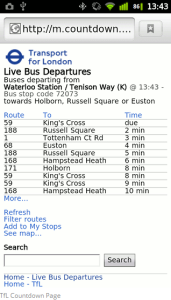Mass Transit and QR Codes
Posted on by Timothy Boyle The Transport of London (TfL) got creative and intelligent with their recent addition to their advertising campaign.; they added a QR code to all of their tube station posters.
The Transport of London (TfL) got creative and intelligent with their recent addition to their advertising campaign.; they added a QR code to all of their tube station posters.
What this QR code does upon scanning is provide passengers with information pertaining to their particular tube stop. They can see where the current bus is departing from and most important, how much longer until the bus is due to arrive.
It might also be important to point out, and give kudos to the TfL for adhering to the QR code best practices; a rarity by today’s marketers it seems. They ensured the landing page was a mobile optimized site, made sure the code was large enough and with a low density so that it was easy to scan, and made sure to have a call to action to entice people to scan the code. All important for a successful QR code campaign.
In the end the campaign was a general success. As of the end of 2012 the TfL QR code campaign was seeing an average scan count of 5,000 a month. Considering the size of the city that may not look like much, but how often do you take action when you see a poster with a website link or phone number? So the QR code it would seem is certainly helping draw people’s interest, at least in a greater way than a traditional advertisement.
After seeing the success of the TfL there is no reason why all mass transit systems across the US, or the world, should not be using this inexpensive marketing tool to provide added value to customers. Even government run transit should be able to jump into the 21st century with this simple technology, the Transport of London was able to, so there is no excuse.

